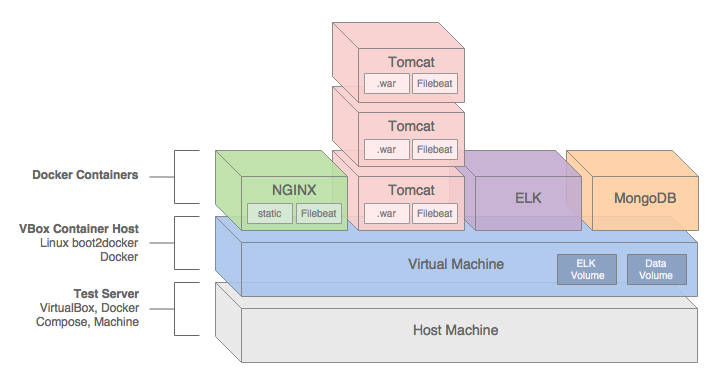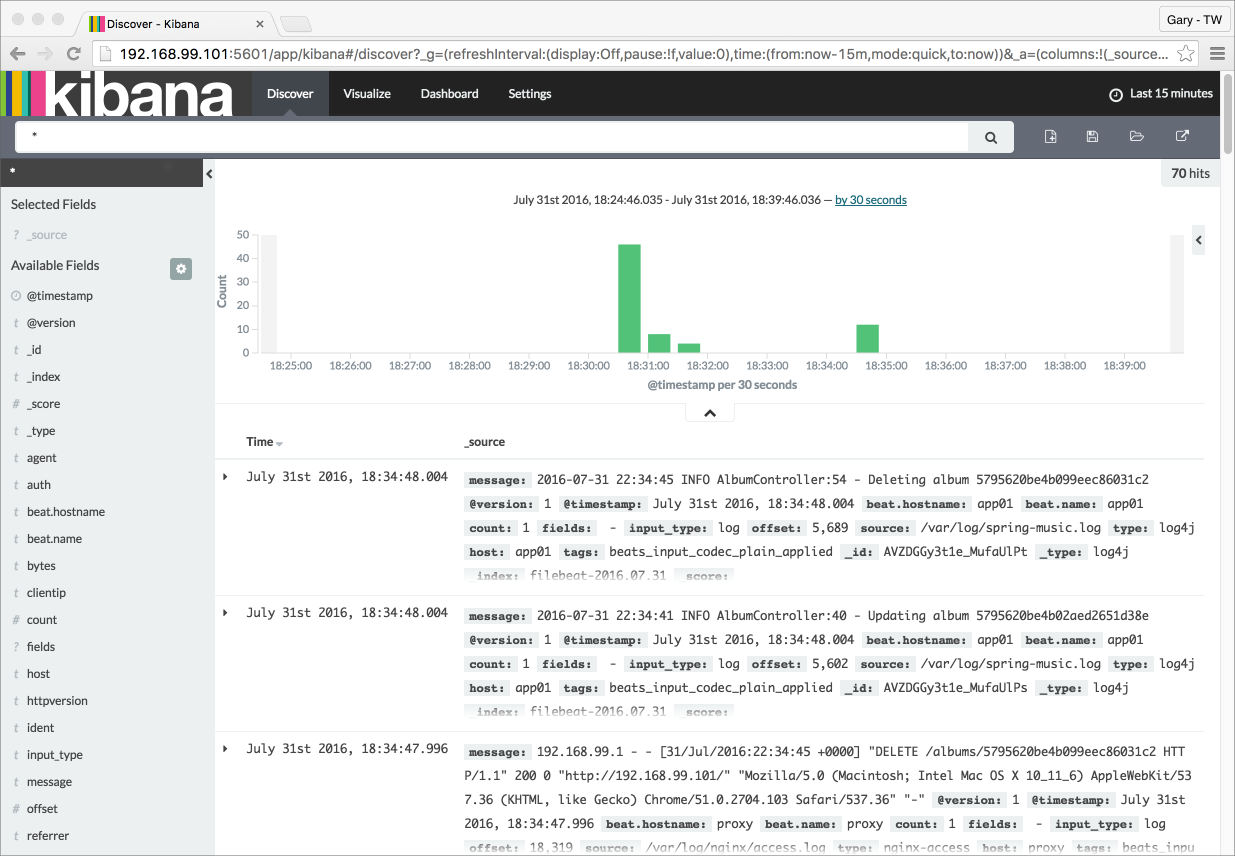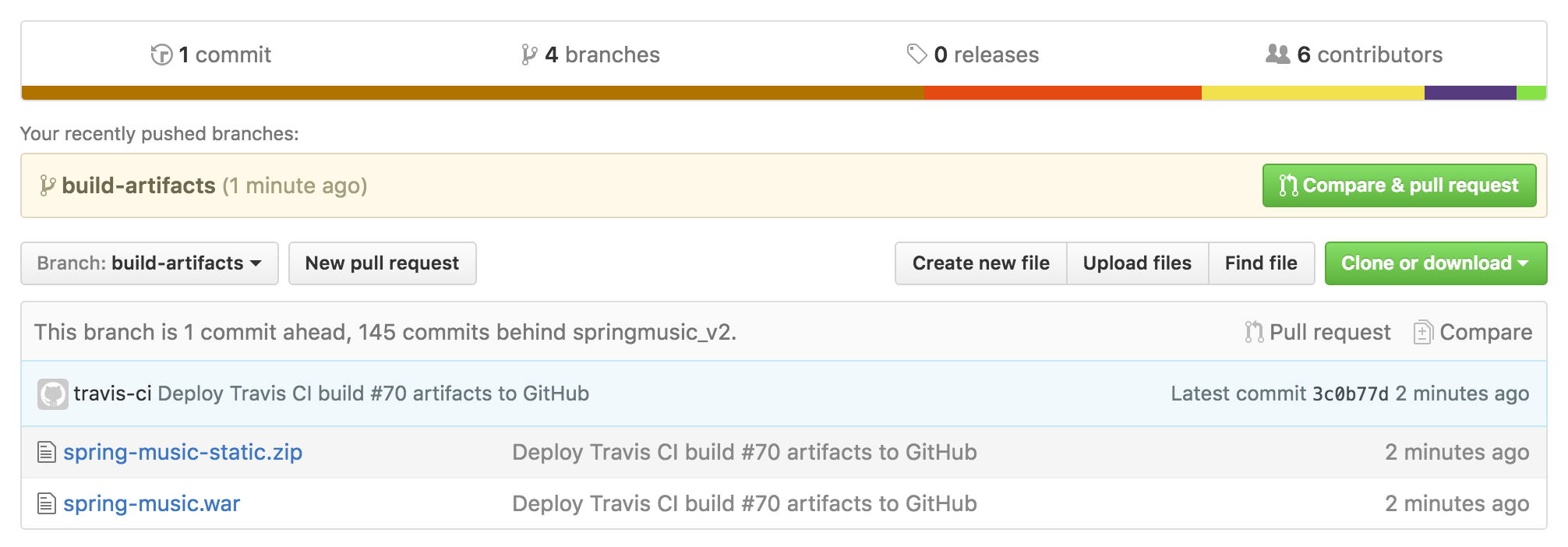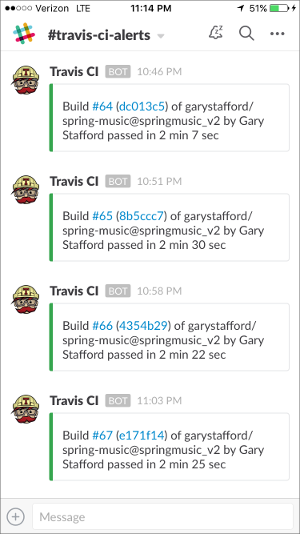Build, deploy, test, and monitor a multi-container, MongoDB-backed, Java Spring web application, using the new Docker 1.12.
This post and associated project code were updated 9/3/2016 to use Tomcat 8.5.4 with OpenJDK 8.
This post and the post's example project represent an update to a previous post, Build and Deploy a Java-Spring-MongoDB Application using Docker. This new post incorporates many improvements made in Docker 1.12, including the use of Docker Compose's v2 YAML format. The post's project was also updated to use Filebeat with ELK, as opposed to Logspout, which was used previously.
In this post, we will demonstrate how to build, test, deploy, and manage a Java Spring web application, hosted on Apache Tomcat, load-balanced by NGINX, monitored by ELK with Filebeat, and all containerized with Docker.
We will use a sample Java Spring application, Spring Music, available on GitHub from Cloud Foundry. The Spring Music sample record album collection application was originally designed to demonstrate the use of database services on Cloud Foundry, using the Spring Framework. Instead of Cloud Foundry, we will host the Spring Music application locally, using Docker on VirtualBox, and optionally on AWS.
All files necessary to build this project are stored on the docker_v2 branch of the garystafford/spring-music-docker repository on GitHub. The Spring Music source code is stored on the springmusic_v2 branch of the garystafford/spring-music repository, also on GitHub.
The Java Spring Music application stack contains the following technologies: Java, Spring Framework, NGINX, Apache Tomcat, MongoDB, the ELK Stack, and Filebeat. Testing frameworks include the Spring MVC Test Framework, Mockito, Hamcrest, and JUnit.
A few changes were necessary to the original Spring Music application to make it work for this demonstration. At a high-level, the changes included:
- Move from Java 1.7 to 1.8 (including newer Tomcat version)
- Add unit tests for Continuous Integration demonstration purposes
- Modify MongoDB configuration class to work with non-local, containerized MongoDB instances
- Add Gradle
warNoStatictask to build WAR without static assets - Add Gradle
zipStatictask to ZIP up the application's static assets for deployment to NGINX - Add Gradle
zipGetVersiontask with a versioning scheme for build artifacts - Add
context.xmlfile andMANIFEST.MFfile to the WAR file - Add Log4j
RollingFileAppenderappender to send log entries to Filebeat - Update versions of several dependencies, including Gradle, Spring, and Tomcat
We will use the following technologies to build, publish, deploy, and host the Java Spring Music application: Gradle, git, GitHub, Travis CI or Semaphore, Oracle VirtualBox, Docker, Docker Compose, Docker Machine, Docker Hub, and optionally, Amazon Web Services (AWS).
To increase performance, the Spring Music web application's static content will be hosted by NGINX. The application's WAR file will be hosted by Apache Tomcat. Requests for non-static content will be proxied through NGINX on the front-end, to a set of three load-balanced Tomcat instances on the back-end. To further increase application performance, NGINX will also be configured for browser caching of the static content. In many enterprise environments, the use of a Java EE application server, like Tomcat, is still not uncommon.
Reverse proxying and caching are configured thought NGINX's default.conf file, in the server configuration section:
server {
listen 80;
server_name proxy;
location ~* \/assets\/(css|images|js|template)\/* {
root /usr/share/nginx/;
expires max;
add_header Pragma public;
add_header Cache-Control "public, must-revalidate, proxy-revalidate";
add_header Vary Accept-Encoding;
access_log off;
}
The three Tomcat instances will be manually configured for load-balancing using NGINX's default round-robin load-balancing algorithm. This is configured through the default.conf file, in the upstream configuration section:
upstream backend {
server music_app_1:8080;
server music_app_2:8080;
server music_app_3:8080;
}
Client requests are received through port 80 on the NGINX server. NGINX redirects requests, which are not for non-static assets, to one of the three Tomcat instances on port 8080.
The Spring Music application was designed to work with a number of data stores, including MySQL, Postgres, Oracle, MongoDB, Redis, and H2, an in-memory Java SQL database. Given the choice of both SQL and NoSQL databases, we will select MongoDB.
The Spring Music application, hosted by Tomcat, will store and modify record album data in a single instance of MongoDB. MongoDB will be populated with a collection of album data from a JSON file, when the Spring Music application first creates the MongoDB database instance.
Lastly, the ELK Stack with Filebeat, will aggregate both Docker and Java Log4j log entries, providing debugging and analytics to our demonstration. A similar method for aggregating logs, using Logspout instead of Filebeat, can be found in this previous post.
In this post's example, two build artifacts, a WAR file for the application and ZIP file for the static web content, are built automatically by Travis CI, whenever source code changes are pushed to the springmusic_v2 branch of the garystafford/spring-music repository on GitHub.
Following a successful build and a small number of unit tests, Travis CI pushes the build artifacts to the build-artifacts branch on the same GitHub project. The build-artifacts branch acts as a pseudo binary repository for the project, much like JFrog's Artifactory. These artifacts are used later by DockerHub to automatically build immutable Docker images.
I've configured Travis CI pushes build notifications to my Slack channel, which eliminates the need to actively monitor Travis CI.
The .travis.yaml file, custom gradle.build Gradle tasks, and the deploy_travisci.sh script, handles the Travis CI automation described, above.
Travis CI .travis.yaml file:
language: java
jdk: oraclejdk8
before_install:
- chmod +x gradlew
before_deploy:
- chmod ugo+x deploy.sh
script:
- ./gradlew wrapper
- ./gradlew clean build
- ./gradlew warNoStatic warCopy zipGetVersion zipStatic
- sh ./deploy_travisci.sh
env:
global:
- GH_REF: github.com/garystafford/spring-music.git
- secure: <GH_TOKEN_secure_hash_here>
- secure: <COMMIT_AUTHOR_EMAIL_secure_hash_here>
notifications:
slack:
- secure: <SLACK_secure_hash_here>Custom gradle.build tasks:
// versioning build artifacts
def major = '2'
def minor = System.env.TRAVIS_BUILD_NUMBER
minor = (minor != 'null') ? minor : System.env.SEMAPHORE_BUILD_NUMBER
minor = (minor != 'null') ? minor : '0'
def artifact_version = major + '.' + minor
// new Gradle build tasks
task warNoStatic(type: War) {
// omit the version from the war file name
version = ''
exclude '**/assets/**'
manifest {
attributes
'Manifest-Version': '1.0',
'Created-By': currentJvm,
'Gradle-Version': GradleVersion.current().getVersion(),
'Implementation-Title': archivesBaseName + '.war',
'Implementation-Version': artifact_version,
'Implementation-Vendor': 'Gary A. Stafford'
}
}
task warCopy(type: Copy) {
from 'build/libs'
into 'build/distributions'
include '**/*.war'
}
task zipGetVersion (type: Task) {
ext.versionfile =
new File("${projectDir}/src/main/webapp/assets/buildinfo.properties")
versionfile.text = 'build.version=' + artifact_version
}
task zipStatic(type: Zip) {
from 'src/main/webapp/assets'
appendix = 'static'
version = ''
}
tomcatRun {
outputFile = file('tomcat.log')
configFile = file('src/main/webapp/META-INF/context.xml')
}The deploy_travisci.sh file:
#!/bin/bash
set -e # exit with nonzero exit code if anything fails
cd build/distributions
git init
git config user.name "travis-ci"
git config user.email "${COMMIT_AUTHOR_EMAIL}"
git add .
git commit -m "Deploy Travis CI Build #${TRAVIS_BUILD_NUMBER} artifacts to GitHub"
git push --force --quiet "https://${GH_TOKEN}@${GH_REF}" \
master:build-artifacts > /dev/null 2>&1You can easily replicate the project's continuous integration automation using your choice of toolchains. GitHub or BitBucket are good choices for distributed version control. For continuous integration and deployment, I recommend Travis CI, Semaphore, Codeship, or Jenkins. Couple this with a good persistent chat application, such as Glider Labs' Slack or Atlassian's HipChat.
Make sure VirtualBox, Docker, Docker Compose, and Docker Machine, are installed and running. At the time of this post, I have the following versions of software installed on my MacBook Pro:
Mac OS X 10.11.6
VirtualBox 5.0.26
Docker 1.12.1-beta25
Docker Compose 1.8.0
Docker Machine 0.8.1
To clone the project, build the host VM, pull and build the Docker images, and build containers, run the build script, using the following command: sh ./build_project.sh. This script is useful when working with CI/CD automation tools, such as Jenkins CI or ThoughtWorks go. However, I strongly suggest manually running each command, to gain a better understand the process.
set -ex
# clone project
git clone -b docker_v2 --single-branch \
https://github.com/garystafford/spring-music-docker.git music \
&& cd "$_"
# provision VirtualBox VM
docker-machine create --driver virtualbox springmusic
# set new environment
docker-machine env springmusic \
&& eval "$(docker-machine env springmusic)"
# mount a named volume on host to store mongo and elk data
# ** assumes your project folder is 'music' **
docker volume create --name music_data
docker volume create --name music_elk
# create bridge network for project
# ** assumes your project folder is 'music' **
docker network create -d bridge music_net
# build images and orchestrate start-up of containers (in this order)
docker-compose -p music up -d elk && sleep 15 \
&& docker-compose -p music up -d mongodb && sleep 15 \
&& docker-compose -p music up -d app \
&& docker-compose scale app=3 && sleep 15 \
&& docker-compose -p music up -d proxy && sleep 15
# optional: configure local DNS resolution for application URL
#echo "$(docker-machine ip springmusic) springmusic.com" | sudo tee --append /etc/hosts
# run a simple connectivity test of application
for i in {1..9}; do curl -I $(docker-machine ip springmusic); doneBy simply changing the Docker Machine driver to AWS EC2 from VirtualBox, and providing your AWS credentials, the springmusic environment can also be built on AWS.
Docker Machine provisions a single VirtualBox springmusic VM on which host the project's containers. VirtualBox provides a quick and easy solution that can be run locally for initial development and testing of the application.
Next, two volumes and project-specific Docker bridge network are built.
Next, using the project's individual Dockerfiles, Docker Compose pulls base Docker images from Docker Hub for NGINX, Tomcat, ELK, and MongoDB. Project-specific immutable Docker images are then built for NGINX, Tomcat, and MongoDB. While constructing the project-specific Docker images for NGINX and Tomcat, the latest Spring Music build artifacts are pulled and installed into the corresponding Docker images.
Finally, Docker Compose builds and deploys (6) containers onto the VirtualBox VM, including (1) NGINX, (3) Tomcat, (1) MongoDB, and (1) ELK.
The NGINX Dockerfile:
# NGINX image with build artifact
FROM nginx:latest
MAINTAINER Gary A. Stafford <[email protected]>
ENV REFRESHED_AT 2016-09-17
ENV GITHUB_REPO https://github.com/garystafford/spring-music/raw/build-artifacts
ENV STATIC_FILE spring-music-static.zip
RUN apt-get update -qq \
&& apt-get install -qqy curl wget unzip nano \
&& apt-get clean \
\
&& wget -O /tmp/${STATIC_FILE} ${GITHUB_REPO}/${STATIC_FILE} \
&& unzip /tmp/${STATIC_FILE} -d /usr/share/nginx/assets/
COPY default.conf /etc/nginx/conf.d/default.conf
# tweak nginx image set-up, remove log symlinks
RUN rm /var/log/nginx/access.log /var/log/nginx/error.log
# install Filebeat
ENV FILEBEAT_VERSION=filebeat_1.2.3_amd64.deb
RUN curl -L -O https://download.elastic.co/beats/filebeat/${FILEBEAT_VERSION} \
&& dpkg -i ${FILEBEAT_VERSION} \
&& rm ${FILEBEAT_VERSION}
# configure Filebeat
ADD filebeat.yml /etc/filebeat/filebeat.yml
# CA cert
RUN mkdir -p /etc/pki/tls/certs
ADD logstash-beats.crt /etc/pki/tls/certs/logstash-beats.crt
# start Filebeat
ADD ./start.sh /usr/local/bin/start.sh
RUN chmod +x /usr/local/bin/start.sh
CMD [ "/usr/local/bin/start.sh" ]
The Tomcat Dockerfile:
# Apache Tomcat image with build artifact
FROM tomcat:8.5.4-jre8
MAINTAINER Gary A. Stafford <[email protected]>
ENV REFRESHED_AT 2016-09-17
ENV GITHUB_REPO https://github.com/garystafford/spring-music/raw/build-artifacts
ENV APP_FILE spring-music.war
ENV TERM xterm
ENV JAVA_OPTS -Djava.security.egd=file:/dev/./urandom
RUN apt-get update -qq \
&& apt-get install -qqy curl wget \
&& apt-get clean \
\
&& touch /var/log/spring-music.log \
&& chmod 666 /var/log/spring-music.log \
\
&& wget -q -O /usr/local/tomcat/webapps/ROOT.war ${GITHUB_REPO}/${APP_FILE} \
&& mv /usr/local/tomcat/webapps/ROOT /usr/local/tomcat/webapps/_ROOT
COPY tomcat-users.xml /usr/local/tomcat/conf/tomcat-users.xml
# install Filebeat
ENV FILEBEAT_VERSION=filebeat_1.2.3_amd64.deb
RUN curl -L -O https://download.elastic.co/beats/filebeat/${FILEBEAT_VERSION} \
&& dpkg -i ${FILEBEAT_VERSION} \
&& rm ${FILEBEAT_VERSION}
# configure Filebeat
ADD filebeat.yml /etc/filebeat/filebeat.yml
# CA cert
RUN mkdir -p /etc/pki/tls/certs
ADD logstash-beats.crt /etc/pki/tls/certs/logstash-beats.crt
# start Filebeat
ADD ./start.sh /usr/local/bin/start.sh
RUN chmod +x /usr/local/bin/start.sh
CMD [ "/usr/local/bin/start.sh" ]
This post was recently updated for Docker 1.12, and to use Docker Compose's v2 YAML file format. The post's docker-compose.yml takes advantage of improvements in Docker 1.12 and Docker Compose's v2 YAML. Improvements to the YAML file include eliminating the need to link containers and expose ports, and the addition of named networks and volumes.
version: '2'
services:
proxy:
build: nginx/
ports:
- 80:80
networks:
- net
depends_on:
- app
hostname: proxy
container_name: proxy
app:
build: tomcat/
ports:
- 8080
networks:
- net
depends_on:
- mongodb
hostname: app
mongodb:
build: mongodb/
ports:
- 27017:27017
networks:
- net
depends_on:
- elk
hostname: mongodb
container_name: mongodb
volumes:
- music_data:/data/db
- music_data:/data/configdb
elk:
image: sebp/elk:latest
ports:
- 5601:5601
- 9200:9200
- 5044:5044
- 5000:5000
networks:
- net
volumes:
- music_elk:/var/lib/elasticsearch
hostname: elk
container_name: elk
volumes:
music_data:
external: true
music_elk:
external: true
networks:
net:
driver: bridgeBelow are the results of building the project.
# Resulting Docker Machine VirtualBox VM:
$ docker-machine ls
NAME ACTIVE DRIVER STATE URL SWARM DOCKER ERRORS
springmusic * virtualbox Running tcp://192.168.99.100:2376 v1.12.1
# Resulting external volume:
$ docker volume ls
DRIVER VOLUME NAME
local music_data
local music_elk
# Resulting bridge network:
$ docker network ls
NETWORK ID NAME DRIVER SCOPE
ca901af3c4cd music_net bridge local
# Resulting Docker images - (4) base images and (3) project images:
$ docker images
REPOSITORY TAG IMAGE ID CREATED SIZE
music_proxy latest 0c7103c814df About a minute ago 250.3 MB
music_app latest 9334e69eb412 2 minutes ago 400.3 MB
music_mongodb latest 55d065b75ac9 3 minutes ago 366.4 MB
nginx latest 4a88d06e26f4 47 hours ago 183.5 MB
sebp/elk latest 2a670b414fba 2 weeks ago 887.2 MB
tomcat 8.5.4-jre8 98cc750770ba 2 weeks ago 334.5 MB
mongo latest 48b8b08dca4d 2 weeks ago 366.4 MB
# Resulting (6) Docker containers
$ docker ps
CONTAINER ID IMAGE COMMAND CREATED STATUS PORTS NAMES
5b3715650db3 music_proxy "/usr/local/bin/start" About a minute ago Up About a minute 0.0.0.0:80->80/tcp, 443/tcp proxy
9204f2959055 music_app "/usr/local/bin/start" 2 minutes ago Up 2 minutes 0.0.0.0:32780->8080/tcp music_app_3
ef97790a820c music_app "/usr/local/bin/start" 2 minutes ago Up 2 minutes 0.0.0.0:32779->8080/tcp music_app_2
3549fd082ca9 music_app "/usr/local/bin/start" 2 minutes ago Up 2 minutes 0.0.0.0:32778->8080/tcp music_app_1
3da692c204da music_mongodb "/entrypoint.sh mongo" 4 minutes ago Up 4 minutes 0.0.0.0:27017->27017/tcp mongodb
2e41cbdbc8e0 sebp/elk:latest "/usr/local/bin/start" 4 minutes ago Up 4 minutes 0.0.0.0:5000->5000/tcp, 0.0.0.0:5044->5044/tcp, 0.0.0.0:5601->5601/tcp, 0.0.0.0:9200->9200/tcp, 9300/tcp elk
Below are partial results of the curl test, hitting the NGINX endpoint. Note the different IP addresses in the Upstream-Address field between requests. This test proves NGINX's round-robin load-balancing is working across the three Tomcat application instances, music_app_1, music_app_2, and music_app_3.
Also, note the sharp decrease in the Request-Time between the first three requests and subsequent three requests. The Upstream-Response-Time to the Tomcat instances doesn't change, yet the total Request-Time is much shorter, due to caching of the application's static assets by NGINX.
$ for i in {1..6}; do curl -I $(docker-machine ip springmusic);done
HTTP/1.1 200
Server: nginx/1.11.4
Date: Sat, 17 Sep 2016 18:33:50 GMT
Content-Type: text/html;charset=ISO-8859-1
Content-Length: 2094
Connection: keep-alive
Accept-Ranges: bytes
ETag: W/"2094-1473924940000"
Last-Modified: Thu, 15 Sep 2016 07:35:40 GMT
Content-Language: en
Request-Time: 0.575
Upstream-Address: 172.18.0.4:8080
Upstream-Response-Time: 1474137230.048
HTTP/1.1 200
Server: nginx/1.11.4
Date: Sat, 17 Sep 2016 18:33:51 GMT
Content-Type: text/html;charset=ISO-8859-1
Content-Length: 2094
Connection: keep-alive
Accept-Ranges: bytes
ETag: W/"2094-1473924940000"
Last-Modified: Thu, 15 Sep 2016 07:35:40 GMT
Content-Language: en
Request-Time: 0.711
Upstream-Address: 172.18.0.5:8080
Upstream-Response-Time: 1474137230.865
HTTP/1.1 200
Server: nginx/1.11.4
Date: Sat, 17 Sep 2016 18:33:52 GMT
Content-Type: text/html;charset=ISO-8859-1
Content-Length: 2094
Connection: keep-alive
Accept-Ranges: bytes
ETag: W/"2094-1473924940000"
Last-Modified: Thu, 15 Sep 2016 07:35:40 GMT
Content-Language: en
Request-Time: 0.326
Upstream-Address: 172.18.0.6:8080
Upstream-Response-Time: 1474137231.812
# assets now cached...
HTTP/1.1 200
Server: nginx/1.11.4
Date: Sat, 17 Sep 2016 18:33:53 GMT
Content-Type: text/html;charset=ISO-8859-1
Content-Length: 2094
Connection: keep-alive
Accept-Ranges: bytes
ETag: W/"2094-1473924940000"
Last-Modified: Thu, 15 Sep 2016 07:35:40 GMT
Content-Language: en
Request-Time: 0.012
Upstream-Address: 172.18.0.4:8080
Upstream-Response-Time: 1474137233.111
HTTP/1.1 200
Server: nginx/1.11.4
Date: Sat, 17 Sep 2016 18:33:53 GMT
Content-Type: text/html;charset=ISO-8859-1
Content-Length: 2094
Connection: keep-alive
Accept-Ranges: bytes
ETag: W/"2094-1473924940000"
Last-Modified: Thu, 15 Sep 2016 07:35:40 GMT
Content-Language: en
Request-Time: 0.017
Upstream-Address: 172.18.0.5:8080
Upstream-Response-Time: 1474137233.350
HTTP/1.1 200
Server: nginx/1.11.4
Date: Sat, 17 Sep 2016 18:33:53 GMT
Content-Type: text/html;charset=ISO-8859-1
Content-Length: 2094
Connection: keep-alive
Accept-Ranges: bytes
ETag: W/"2094-1473924940000"
Last-Modified: Thu, 15 Sep 2016 07:35:40 GMT
Content-Language: en
Request-Time: 0.013
Upstream-Address: 172.18.0.6:8080
Upstream-Response-Time: 1474137233.594
Assuming the springmusic VM is running at 192.168.99.100, the following links can be used to access various project endpoints. Note the Tomcat instances each map to randomly exposed ports. These ports are not required by NGINX, which maps to port 8080 for each instance. The port is only required if you want access to the Tomcat Web Console. The port shown below, 32771, is merely used as an example.
- Spring Music Application: 192.168.99.100
- NGINX Status: 192.168.99.100/nginx_status
- Tomcat Web Console - music_app_1*: 192.168.99.100:32771/manager
- Environment Variables - music_app_1: 192.168.99.100:32771/env
- Album List (RESTful endpoint) - music_app_1: 192.168.99.100:32771/albums
- Elasticsearch Info: 192.168.99.100:9200
- Elasticsearch Status: 192.168.99.100:9200/_status?pretty
- Kibana Web Console: 192.168.99.100:5601
* The Tomcat user name is admin and the password is t0mcat53rv3r.
- Automate the Docker image build and publish processes
- Automate the Docker container build and deploy processes
- Automate post-deployment verification testing of project infrastructure
- Add Docker Swarm multi-host capabilities with overlay networking
- Update Spring Music with latest CF Spring Boot project revisions
- Include scripting example to stand-up project on AWS
- Add Consul and Consul Template for NGINX configuration
- Cloud Foundry's Spring Music Example
- Getting Started with Gradle for Java
- Introduction to Gradle
- Spring Framework
- Understanding Nginx HTTP Proxying, Load Balancing, Buffering, and Caching
- Common conversion patterns for log4j's PatternLayout
- Spring @PropertySource example
- Java log4j logging
- Spring Test MVC ResultMatchers





